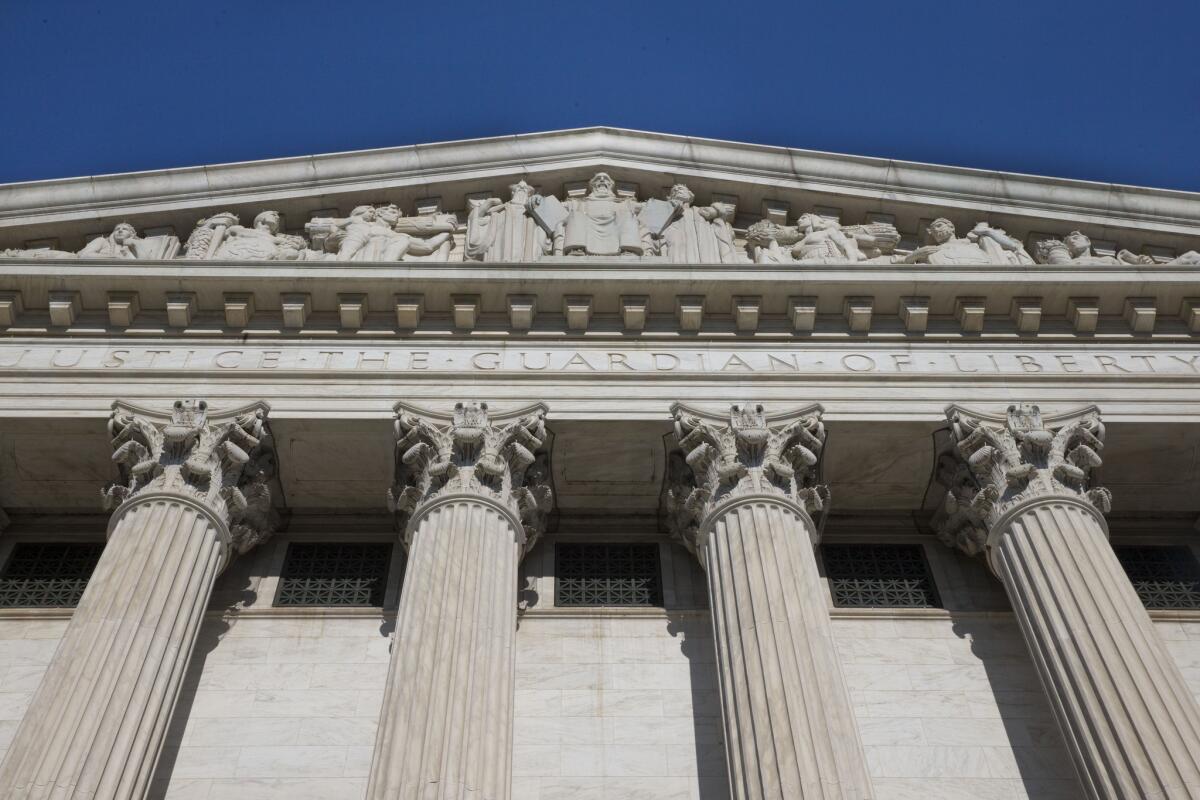California officials praise Supreme Court ruling on independent redistricting commissions

The Supreme Court met for the final time until the fall to decide three remaining cases and add some new ones for the term that starts in October.
Reporting from Washington — Political reformers in California and Arizona and the voters who supported them won a big round at the Supreme Court on Monday, when the justices upheld the use of independent redistricting commissions to draw election districts for members of Congress.
In a 5-4 decision, the justices said the Constitution did not prevent states from taking this power away from elected politicians and lodging it in the hands of a nonpartisan board.
The goal is to prevent partisan gerrymandering where lawmakers draw safe seats for their friends and allies. Arizona’s Republican Legislature went to court to challenge the decision of their voters, but they fell one vote short at the high court.
Justice Ruth Bader Ginsburg said the Constitution gives states broad leeway to decide on their election rules, and states like Arizona and California may rely on “direct democracy,” which allows the voters to decide.
“There’s no constitutional barrier to a state’s empowerment of its people,” she said in the courtroom. “The people of Arizona turned to the initiative to curb the practice of gerrymandering,” she said, and nothing in the Constitution forbids them from making that decision.
The four most conservatives justices dissented.
Chief Justice John G. Roberts Jr. accused the majority of performing a “magic trick” by interpreting the Constitution to allow the people, not the Legislature, to set the rules for electing members of Congress.
He agreed with Arizona’s Republican Legislature that it should have the exclusive power to decide on districts for members of Congress. Justices Antonin Scalia, Clarence Thomas and Samuel A. Alito Jr. agreed.
The decision turned on a somewhat obscure provision in the Constitution. It says: “The times, places and manners of holding elections for senators and representatives, shall be prescribed in each state by the legislature thereof, but the Congress may at any time by law make or alter such regulations.”
Arizona’s voters passed a state constitutional amendment in 2000 to remove the redistricting authority from the state Legislature and to turn it over to a new Arizona Independent Redistricting Commission.
Three years ago, Arizona’s Republican lawmakers sued in federal court seeking to overturn the amendment, saying the Constitution reserved this power to “the legislature thereof,” and this authority may not be taken away.
Defenders of the commission argued the state’s lawmaking authority can rest with the people when they pass propositions.
If the court had struck down the independent commissions in Arizona State Legislature vs. Arizona Independent Redistricting Commission, it would have threatened numerous congressional districts in Arizona and California that were drawn by nonpartisan citizen commissions.
In addition, five other states have semi-independent commissions that could have been affected by the ruling: Washington, Idaho, Montana, Hawaii and New Jersey.
Richard Hasen, an election law expert at UC Irvine, called the ruling a rejection of “mindless literal reading” of a constitutional provision.
The decision is a victory for reformers who see independent commissions as the best weapon to stop politicians from manipulating electoral district lines to protect incumbents or political fiefdoms. Three former California governors - Pete Wilson, George Deukmejian and Arnold Schwarzenegger - filed a friend-of-the-court brief urging the justices to uphold the state’s independent panel.
With 53 members, the California delegation in the House of Representatives, 38 Democrats and 15 Republicans, is the largest in Congress.
In 2008, Californians approved a ballot measure to shift the redistricting power for state Legislature seats to a citizens commission. Two years later, voters approved a second measure to extend its authority to congressional districts.
California Republican Party Chairman Jim Brulte praised the Supreme Court ruling, saying that if it had gone the other way, he fully expected the Democratic-controlled Legislature to take full political advantage.
“It is an inherent conflict of interest for a legislator to draw their own legislative districts, or congressional districts that they may run for,’’ Brulte said. “Redistricting is the most partisan political activity that a legislative body can engage in, so allowing a citizens commission to draw legislative and congressional districts makes a lot sense to me.’’
Paul Mitchell, a Democratic redistricting expert, said the Supreme Court’s “surprise” ruling probably spared California from years of political upheaval.
The decision, in effect, could offer stability to most California congressional district boundaries for decades, he said.
The independent commission is required to respect community boundaries and consider “communities of interest,” which include minorities. While some districts may change to ensure fair representation to California’s growing Latino and Asian American populations, there won’t be wholesale changes to boundaries across the state.
“We won’t see massive changes,” Mitchell said.
The exception may be in the areas around four California counties – Kings, Merced, Monterey and Yuba. In 2012, the independent redistricting commission “bent over backward” to ensure the new political boundaries did not discriminate against minorities in those counties, which had a history of discrimination and required federal approval before changing election procedures, Mitchell said.
Some advocates expressed optimism that the decision would buoy efforts to reform redistricting processes in other states.
“It gives momentum to reformers across the spectrum because it removes an ambiguity about whether these sorts of commissions were constitutional,” said Michael Li, a redistricting expert at the Brennan Center for Justice.
In Ohio, for example, a proposal on the ballot this year would overhaul how state legislative districts are drawn. According to Ohio State University professor Edward Foley, some involved in the process were hesitant to act on a congressional redistricting reform proposal while the case was undecided.
“It was seen as a nonstarter,” Foley said. Now the Supreme Court has “given a green light” to overhaul congressional redistricting, he added.
Other supporters of redistricting questioned whether the ruling would jump-start additional reform efforts.
“Proponents of redistricting reform have dodged a bullet, but it’s not like it gives them a great big gun of their own to use,” said Norman Ornstein, a resident scholar at the American Enterprise Institute.
The process of organizing such initiatives, Ornstein and others noted, will remain expensive and complex.
“The greatest impediment to the formation of these commissions has always been political, not legal,” said Stanford Law School professor Nathaniel Persily.
Times staff writers Colin Diersing in Washington and Phil Willon in Sacramento contributed to this report.
Twitter: @DavidGSavage
More to Read
Sign up for Essential California
The most important California stories and recommendations in your inbox every morning.
You may occasionally receive promotional content from the Los Angeles Times.











